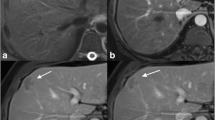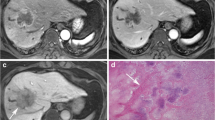Abstract
Objectives
To determine the different imaging features of intrahepatic mass-forming cholangiocarcinoma (IMCC) from hepatocellular carcinoma (HCC) on gadoxetic acid-enhanced magnetic resonance imaging (MRI).
Methods
This retrospective study was institutional review board approved and the requirement for informed consent was waived. Patients who underwent gadoxetic acid-enhanced MRI with histologically confirmed IMCCs (n = 46) or HCCs (n = 58) were included. Imaging features of IMCCs and HCCs on gadoxetic acid-enhanced MRI including T2- and T1-weighted, diffusion weighted images, dynamic study and hepatobiliary phase (HBP) images were analyzed. Univariate and multivariate logistic regression analyses were performed to identify relevant differentiating features between IMCCs and HCCs.
Results
Multivariate analysis revealed heterogeneous T2 signal intensity and a hypointense rim on the HBP as suggestive findings of IMCCs and the wash-in and “portal wash-out” enhancement pattern as well as focal T1 high signal intensity foci as indicative of HCCs (all, p < 0.05). When we combined any three of the above four imaging features, we were able to diagnose IMCCs with 94 % (43/46) sensitivity and 86 % (50/58) specificity.
Conclusions
Combined interpretation of enhancement characteristics including HBP images, morphologic features, and strict application of the “portal wash-out” pattern helped more accurate discrimination of IMCCs from HCCs.
Key Points
• Analysis of enhancement characteristics helped accurate discrimination of IMCCs from HCCs.
• Wash-out should be determined on the PVP of gadoxetic acid-enhanced MRI.
• A hypointense rim on the HBP was a significant finding of IMCCs.




Similar content being viewed by others
Abbreviations
- AP:
-
Arterial phase
- HBP:
-
Hepatobiliary phase
- HCC:
-
Hepatocellular carcinoma
- IMCC:
-
Intrahepatic mass-forming cholangiocarcinoma
- MRI:
-
Agnetic resonance imaging
- PVP:
-
Portal venous phase
- TP:
-
Transitional phase
References
Manfredi R, Barbaro B, Masselli G, Vecchioli A, Marano P (2004) Magnetic resonance imaging of cholangiocarcinoma. Semin Liver Dis 24:155–164
Khan SA, Thomas HC, Davidson BR, Taylor-Robinson SD (2005) Cholangiocarcinoma. Lancet 366:1303–1314
Fowler KJ, Brown JJ, Narra VR (2011) Magnetic resonance imaging of focal liver lesions: approach to imaging diagnosis. Hepatology 54:2227–2237
Albiin N (2012) MRI of Focal Liver Lesions. Curr Med Imaging Rev 8:107–116
Zhang Y, Uchida M, Abe T, Nishimura H, Hayabuchi N, Nakashima Y (1999) Intrahepatic peripheral cholangiocarcinoma: comparison of dynamic CT and dynamic MRI. J Comput Assist Tomogr 23:670–677
Péporté AR, Sommer WH, Nikolaou K, Reiser MF, Zech CJ (2013) Imaging features of intrahepatic cholangiocarcinoma in Gd-EOB-DTPA-enhanced MRI. Eur J Radiol 82:e101–e106
Yamamoto M, Ariizumi S (2011) Surgical outcomes of intrahepatic cholangiocarcinoma. Surg Today 41:896–9028
Kim SJ, Lee JM, Han JK, Kim KH, Lee JY, Choi BI (2007) Peripheral mass-forming cholangiocarcinoma in cirrhotic liver. Am J Roentgenol 189:1428–14349
Vilana R, Forner A, Bianchi L et al (2010) Intrahepatic peripheral cholangiocarcinoma in cirrhosis patients may display a vascular pattern similar to hepatocellular carcinoma on contrast‐enhanced ultrasound. Hepatology 51:2020–2029
Kim BK, Kang WJ, Kim JK et al (2011) 18F-fluorodeoxyglucose uptake on positron emission tomography as a prognostic predictor in locally advanced hepatocellular carcinoma. Cancer 117:4779–4787
Xu J, Igarashi S, Sasaki M et al (2012) Intrahepatic cholangiocarcinomas in cirrhosis are hypervascular in comparison with those in normal livers. Liver Int 32:1156–1164
Burra P, Bizzaro D, Ciccocioppo R et al (2011) Therapeutic application of stem cells in gastroenterology: an up-date. World J Gastroenterol 17:3870–3880
Cardinale V, Semeraro R, Torrice A et al (2010) Intra-hepatic and extra-hepatic cholangiocarcinoma: New insight into epidemiology and risk factors. World J Gastrointest Oncol 2:407–416
Shaib YH, El-Serag HB, Davila JA, Morgan R, McGlynn KA (2005) Risk factors of intrahepatic cholangiocarcinoma in the United States: a case–control study. Gastroenterology 128:620–626
European Association For The Study Of The Liver, European Organisation For Research And Treatment Of Cancer (2012) EASL-EORTC clinical practice guidelines: management of hepatocellular carcinoma. J Hepatol 56:908–943
Bruix J, Sherman M (2011) Management of hepatocellular carcinoma: an update. Hepatology 53:1020–1022
Joo I, Choi BI (2012) New paradigm for management of hepatocellular carcinoma by imaging. Liver Cancer 1:94–109
Haimerl M, Wachtler M, Platzek I et al (2013) Added value of Gd-EOB-DTPA-enhanced Hepatobiliary phase MR imaging in evaluation of focal solid hepatic lesions. BMC Med Imaging 13:41
Sun HY, Lee JM, Shin CI et al (2010) Gadoxetic acid-enhanced magnetic resonance imaging for differentiating small hepatocellular carcinomas (< or =2 cm in diameter) from arterial enhancing pseudolesions: special emphasis on hepatobiliary phase imaging. Invest Radiol 45:96–103
Choi JY, Lee JM, Sirlin CB (2014) CT and MR Imaging Diagnosis and Staging of Hepatocellular Carcinoma: Part II. Extracellular Agents, Hepatobiliary Agents, and Ancillary Imaging Features. Radiology 273:30–50
Koh J, Chung YE, Nahm JH et al (2015) Intrahepatic mass-forming cholangiocarcinoma: prognostic value of preoperative gadoxetic acid-enhanced MRI. Eur Radiol. doi:10.1007/s00330-015-3846-5
Higaki A, Ito K, Tamada T et al (2014) Prognosis of small hepatocellular nodules detected only at the hepatobiliary phase of Gd-EOB-DTPA-enhanced MR imaging as hypointensity in cirrhosis or chronic hepatitis. Eur Radiol 24:2476–2481
Kang YS, Lee JM, Kim SH, Han JK, Choi BI (2012) Intrahepatic mass-forming cholangiocarcinoma: enhancement patterns on gadoxetic acid-enhanced MR images. Radiology 264:751–760
Lee JM, Zech CJ, Bolondi L et al (2011) Consensus report of the 4th International Forum for Gadolinium-Ethoxybenzyl-Diethylenetriamine Pentaacetic Acid Magnetic Resonance Imaging. Korean J Radiol 12:403–415
Chong Y, Kim Y, Lee M et al (2012) Differentiating mass-forming intrahepatic cholangiocarcinoma from atypical hepatocellular carcinoma using gadoxetic acid-enhanced MRI. Clin Radiol 67:766–773
Park HJ, Kim YK, Park MJ, Lee WJ (2013) Small intrahepatic mass-forming cholangiocarcinoma: target sign on diffusion-weighted imaging for differentiation from hepatocellular carcinoma. Abdom Imaging 38:793–801
Ishigami K, Yoshimitsu K, Nishihara Y et al (2009) Hepatocellular Carcinoma with a Pseudocapsule on Gadolinium-enhanced MR Images: Correlation with Histopathologic Findings 1. Radiology 250:435–443
Burns PN, Wilson SR (2007) Focal liver masses: enhancement patterns on contrast-enhanced images--concordance of US scans with CT scans and MR images. Radiology 242:162–174
Jeong HT, Kim MJ, Chung YE, Choi JY, Park YN, Kim KW (2013) Gadoxetate disodium-enhanced MRI of mass-forming intrahepatic cholangiocarcinomas: imaging-histologic correlation. Am J Roentgenol 201:W603–W611
Landis JR, Koch GG (1977) The measurement of observer agreement for categorical data. Biometrics 33:159–174
Leoni S, Piscaglia F, Golfieri R et al (2010) The impact of vascular and nonvascular findings on the noninvasive diagnosis of small hepatocellular carcinoma based on the EASL and AASLD criteria. Am J Gastroenterol 105:599–609
Kim SH, Lee CH, Kim BH et al (2012) Typical and atypical imaging findings of intrahepatic cholangiocarcinoma using gadolinium ethoxybenzyl diethylenetriamine pentaacetic acid-enhanced magnetic resonance imaging. J Comput Assist Tomogr 36:704–709
Hope TA, Fowler KJ, Sirlin CB et al (2014) Hepatobiliary agents and their role in LI-RADS. Abdom Imaging 40:613–625
Husarik DB, Gupta RT, Ringe KI, Boll DT, Merkle EM (2011) Contrast enhanced liver MRI in patients with primary sclerosing cholangitis: inverse appearance of focal confluent fibrosis on delayed phase MR images with hepatocyte specific versus extracellular gadolinium based contrast agents. Acad Radiol 18:1549–1554
Doo KW, Lee CH, Choi JW, Lee J, Kim KA, Park CM (2009) “Pseudo Washout” Sign in High-Flow Hepatic Hemangioma on Gadoxetic Acid Contrast-Enhanced MRI Mimicking Hypervascular Tumor. Am J Roentgenol 193:490–496
Jeon TY, Kim SH, Lee WJ, Lim HK (2010) The value of gadobenate dimeglumine-enhanced hepatobiliary-phase MR imaging for the differentiation of scirrhous hepatocellular carcinoma and cholangiocarcinoma with or without hepatocellular carcinoma. Abdom Imaging 35:337–345
Nishie A, Yoshimitsu K, Asayama Y et al (2005) Detection of combined hepatocellular and cholangiocarcinomas on enhanced CT: comparison with histologic findings. Am J Roentgenol 184:1157–1162
Okamura N, Yoshida M, Shibuya A, Sugiura H, Okayasu I, Ohbu M (2005) Cellular and stromal characteristics in the scirrhous hepatocellular carcinoma: comparison with hepatocellular carcinomas and intrahepatic cholangiocarcinomas. PatholInt 55:724–731
Hwang J, Kim YK, Park MJ et al (2012) Differentiating combined hepatocellular and cholangiocarcinoma from mass‐forming intrahepatic cholangiocarcinoma using gadoxetic acid‐enhanced MRI. J Magn Reson Imaging 36:881–889
Gabata T, Matsui O, Kadoya M et al (1998) Delayed MR imaging of the liver: correlation of delayed enhancement of hepatic tumors and pathologic appearance. Abdom Imaging 23:309–313
Purysko AS, Remer EM, Coppa CP, Leão Filho HM, Thupili CR, Veniero JC (2012) LI-RADS: a case-based review of the new categorization of liver findings in patients with end-stage liver disease. Radiographics 32:1977–1995
Tyson GL, El-Serag HB (2011) Risk factors for cholangiocarcinoma. Hepatology 54:173–184
Sheng RF, Zeng MS, Rao SX, Ji Y, Chen LL (2014) MRI of small intrahepatic mass-forming cholangiocarcinoma and atypical small hepatocellular carcinoma (</=3 cm) with cirrhosis and chronic viral hepatitis: a comparative study. Clin Imaging 38:265–272
Acknowledgments
The scientific guarantor of this publication is Byung Ihn Choi. The authors of this manuscript declare relationships with the following companies: Jeong Min Lee is a consultant for Siemens Healthcare; has received grants from GE Healthcare, Donseo Medical, CMS, Acuzen, Starmed, and RF MEDICAL and nonfinancial technical support from Siemens Healthcare; grants from Donseo Medical, CMS, Acuzen, Starmed, RF Medical, and Bayer Healthcare; personal fees from Bayer Healthcare for lectures. Byung Ihn Choi received a grant from Samsung Electronics.
The authors state that this work has not received any funding. No complex statistical methods were necessary for this paper. Institutional Review Board approval was obtained. Written informed consent was waived by the Institutional Review Board. Methodology: retrospective, case–control study, performed at one institution.
Author information
Authors and Affiliations
Corresponding author
Rights and permissions
About this article
Cite this article
Kim, R., Lee, J.M., Shin, CI. et al. Differentiation of intrahepatic mass-forming cholangiocarcinoma from hepatocellular carcinoma on gadoxetic acid-enhanced liver MR imaging. Eur Radiol 26, 1808–1817 (2016). https://doi.org/10.1007/s00330-015-4005-8
Received:
Revised:
Accepted:
Published:
Issue Date:
DOI: https://doi.org/10.1007/s00330-015-4005-8




